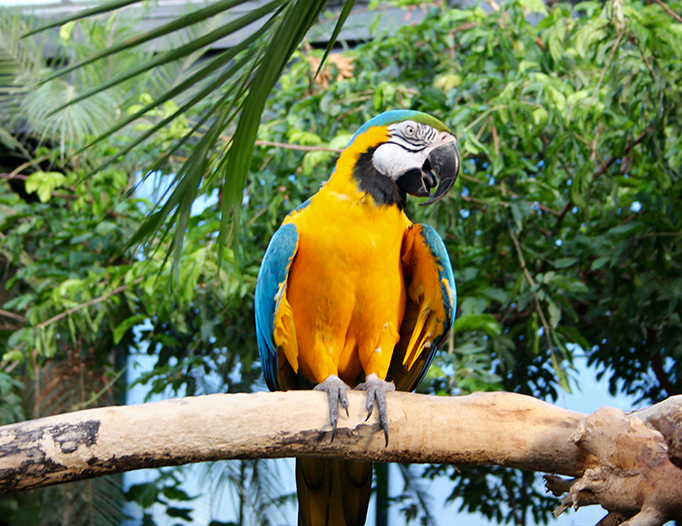Total Weight
Height
Diet
Lifespan
Total Weight
Height
Diet
Lifespan
The Scarlet macaw is a brilliantly colored parrot found in Central and South America. Known for its vibrant plumage,
it is highly intelligent, social, and can live up to 50 years. However, habitat loss and illegal pet trade have led to its endangered status.
The enclosure of scarlet macaws in Patna zoo is spacious, enriched with natural perches, branches, and foliage. It mimics their
native habitat, allowing them to y and display their vibrant plumage. Dedicated caretakers ensure their wellbeing,
providing a balanced diet and promoting their natural behaviour.


The Ara macao, commonly known as the Scarlet Macaw, is a vibrant and intelligent parrot species native
to Central and South America. Recognized for its striking red, yellow, and blue plumage, this large bird is a popular
attraction at Patna Zoo. Scarlet Macaws are known for their strong beaks, long tails, and loud calls, making them fascinating to observe.
They are highly social and can mimic sounds, displaying remarkable intelligence. In the wild, they inhabit tropical rainforests
and play a crucial role in seed dispersal. Conservation efforts at Patna Zoo help protect this beautiful species from habitat
loss and illegal pet trade.
The Scarlet Macaw (Ara macao) is a breathtaking sight at Patna Zoo, known for its brilliant red, yellow, and blue feathers.
At Patna Zoo, conservation efforts ensure their protection from habitat loss and illegal pet trade. Don’t miss the chance to witness this vibrant beauty up close!
| Attribute | Details |
|---|---|
| Weight | Varies by species, typically 0.1 to 1.5 kg |
| Height | Ranges from 4 inches (small parrots) to over 3 feet (larger species like macaws) |
| Diet | Fruits, seeds, nuts, flowers, nectar, and small insects |
| Lifespan | 30-40 years in the wild, longer in captivity |
| Conservation Status | Varies from Least Concern to Critically Endangered depending on species |
| Population in the Wild | Population varies widely across species and regions, with some facing severe decline |
| Social Structure | Highly social — often live in flocks, forming strong bonds with mates and companions |
| Unique Behavior | Excellent mimics — many parrots can imitate human speech and environmental sounds |
| Feeding Pattern | Omnivores — foraging throughout the day, using strong beaks to crack seeds and nutst |
| Feather Feature | Brightly colored feathers, often featuring vibrant greens, reds, blues, and yellows |
| Closest Relatives | Related to cockatoos and lorikeets — all part of the parrot family (Psittacidae) |
Parrots are omnivores, meaning they enjoy a varied diet that includes both plant-based foods and small animal matter. Their meals mainly consist of fruits, seeds, nuts, flowers, and tender leaves, but they may also snack on insects and small invertebrates when available. Parrots are skilled foragers, using their strong, curved beaks to crack open nuts and seeds, while their agile tongues help them extract nectar from flowers.
Parrots also play a key role in their ecosystems by spreading seeds, which helps maintain healthy forests and plant diversity. Their diet changes based on their natural habitat and seasonal food availability, with some species relying more heavily on fruits and others on seeds or blossoms.
Open Now
All visits to Patna Zoo help fund our work both at the zoo and worldwide.